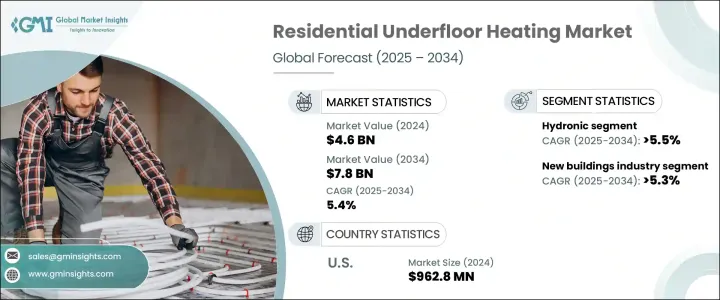
2024년 세계 주택용 바닥 난방 시장 규모는 46억 달러로 평가되었고, 에너지 효율 규제 강화, 환경 문제에 대한 관심 증가, 난방 비용 절감 요구 증가로 에너지 효율적인 난방 솔루션에 대한 수요가 높아지고, CAGR 5.4%로 성장해 2034년에는 78억 달러에 달할 것으로 예측되고 있습니다.
태양열 시스템, 지열 에너지, 히트 펌프 등의 재생에너지원을 바닥 난방 시스템에 통합하는 것이 일반적으로 되어, 이산화탄소 배출량을 삭감하면서 효율과 지속가능성을 높이고 있습니다.

게다가 인공지능(AI)의 도입을 포함한 기술의 진보로 바닥 난방 시스템의 성능이 크게 향상되고 있습니다. 시장은 특히 프로젝트 일정을 지연시키고 글로벌 공급망을 혼란에 빠뜨려 바닥 난방 솔루션 배포에 영향을 미칠 수 있는 관세와 관련된 문제에 직면해 있습니다.
| 시장 범위 | |
|---|---|
| 시작 연도 | 2024년 |
| 예측 연도 | 2025-2034년 |
| 시작 금액 | 46억 달러 |
| 예측 금액 | 78억 달러 |
| CAGR | 5.4% |
수열식 바닥 난방 시스템 부문은 2034년까지 CAGR 5.5%로 성장할 것으로 예상됩니다. 이 시스템은 바닥 아래 파이프를 통해 흐르는 온수를 활용하여 효율적이고 균일 한 열을 제공합니다. 기술 혁신은 온수식 바닥 난방의 신뢰성과 효율성을 향상시키는 데 도움이 되며 시장의 주요 진출기업으로 자리매김하고 있습니다. 에너지 절약 가능성이 있는 리노베이션 건축물도 바닥 난방의 성장에 기여하고 있으며, 이러한 시스템은 기존 난방 방법보다 깨끗하고 에너지 효율적인 대안을 제공합니다.
리노베이션 설치 및 빌딩은 2034년까지 연평균 복합 성장률(CAGR) 5%로 성장할 것으로 예측되며, 이는 기존 인프라를 최신 에너지 효율 기술로 업그레이드하는 지속적인 노력에 힘입어 있습니다. 이러한 업그레이드는 환경에 미치는 영향을 줄이고 실내 편안함을 향상시키고 전반적인 에너지 성능을 향상시키는 것을 목표로 합니다. 수열식 바닥 난방 및 전기식 바닥 난방 시스템을 포함한 저탄소 대체 난방 설비로 개조된 구형 구조물은 에너지 사용을 줄이고 온실 가스 배출량을 줄일 수 있는 큰 기회를 제공합니다.
미국 주택용 바닥 난방 시장은 2024년에 9억 6,280만 달러로 평가되었습니다. 이것은 기존의 난방 방법을 대체하는 지속 가능한 대안을 주택 소유자에게 요구하도록 촉구하는 엄격한 환경 규제의 실시가 증가하고 있음을 배경으로 에너지 효율적인 난방 솔루션에 대한 수요가 크게 급증하고 있음을 반영하고 있습니다.
세계 주택용 바닥 난방 시장의 주요 기업은 Danfoss, Devex Systems, Elektra, Heat Mat, Hemstedt, Hurlcon Hydronic Heating, Magnum Heating, Mysa Smart Thermostats, OJ Electronics, Rehau, Schluter-Systems, Thermosoft, UFHN, Upnor, Warmboard, Warmup, Watts 등이 있습니다. 기업은 스마트 난방 시스템에 투자하고 에너지 관리를 개선하기 위해 AI 주도의 제어를 통합하고 있으며, 많은 기업이 재생에너지 솔루션에 대응한 제품 제공을 강화하고 있으며, 지속가능성의 목표와 친환경 난방 솔루션에 대한 수요 증가에 대응하고 있습니다.
The Global Residential Underfloor Heating Market was valued at USD 4.6 billion in 2024 and is estimated to grow at a CAGR of 5.4% to reach USD 7.8 billion by 2034, driven by the increasing demand for energy-efficient heating solutions, spurred by stricter energy efficiency regulations, heightened environmental concerns, and the growing need to reduce heating costs. Integrating renewable energy sources such as solar thermal systems, geothermal energy, and heat pumps into underfloor heating systems has become more common, enhancing their efficiency and sustainability while lowering carbon emissions. These systems are especially beneficial in both new and existing buildings, offering a significant reduction in reliance on fossil fuels.

Moreover, technological advancements, including the introduction of artificial intelligence (AI), have greatly improved the performance of underfloor heating systems. Smart climate controls, energy savings, and real-time tracking now contribute to lowering energy consumption. However, the market does face challenges, particularly related to tariffs that could delay project timelines and disrupt global supply chains, impacting the deployment of underfloor heating solutions. Despite these hurdles, companies are seeking alternative suppliers and increasing domestic manufacturing to mitigate the effects of these trade barriers.
| Market Scope | |
|---|---|
| Start Year | 2024 |
| Forecast Year | 2025-2034 |
| Start Value | $4.6 Billion |
| Forecast Value | $7.8 Billion |
| CAGR | 5.4% |
Hydronic underfloor heating systems segment is expected to grow at a rate of 5.5% by 2034. These systems use warm water flowing through pipes beneath the floor to provide efficient and uniform heat. Technological innovations are helping to improve the reliability and effectiveness of hydronic heating, positioning it as a key player in the market. Retrofit buildings, with their potential for energy savings, are also contributing to the growth of underfloor heating, with these systems offering a cleaner, more energy-efficient alternative to traditional heating methods.
Retrofit buildings are projected to grow at a CAGR of 5% by 2034, supported by ongoing initiatives to upgrade existing infrastructure with modern, energy-efficient technologies. These upgrades aim to lower environmental impact, improve indoor comfort, and boost overall energy performance. Older structures retrofitted with low-carbon heating alternatives, such as hydronic and electric underfloor heating systems, offer considerable opportunities to cut down on energy usage and reduce greenhouse gas emissions.
United States Residential Underfloor Heating Market was valued at USD 962.8 million in 2024, reflecting a significant surge in demand for energy-efficient heating solutions driven by the increasing implementation of stringent environmental regulations that encourage homeowners to seek sustainable alternatives to traditional heating methods. Radiant floor heating systems, known for their ability to provide consistent warmth while minimizing energy consumption, are becoming a popular choice.
Major companies in the Global Residential Underfloor Heating Market include Danfoss, Devex Systems, Elektra, Heat Mat, Hemstedt, Hurlcon Hydronic Heating, Magnum Heating, Mysa Smart Thermostats, OJ Electronics, Rehau, Schluter-Systems, Thermosoft, UFHN, Uponor, Warmboard, Warmup, and Watts. To strengthen their market presence, companies in the residential underfloor heating industry are focusing on technological innovation and product diversification. Leading players are investing in smart heating systems, integrating AI-driven controls to improve energy management. Many companies are also enhancing their product offerings to accommodate renewable energy solutions, helping meet sustainability goals and rising demand for eco-friendly heating solutions.